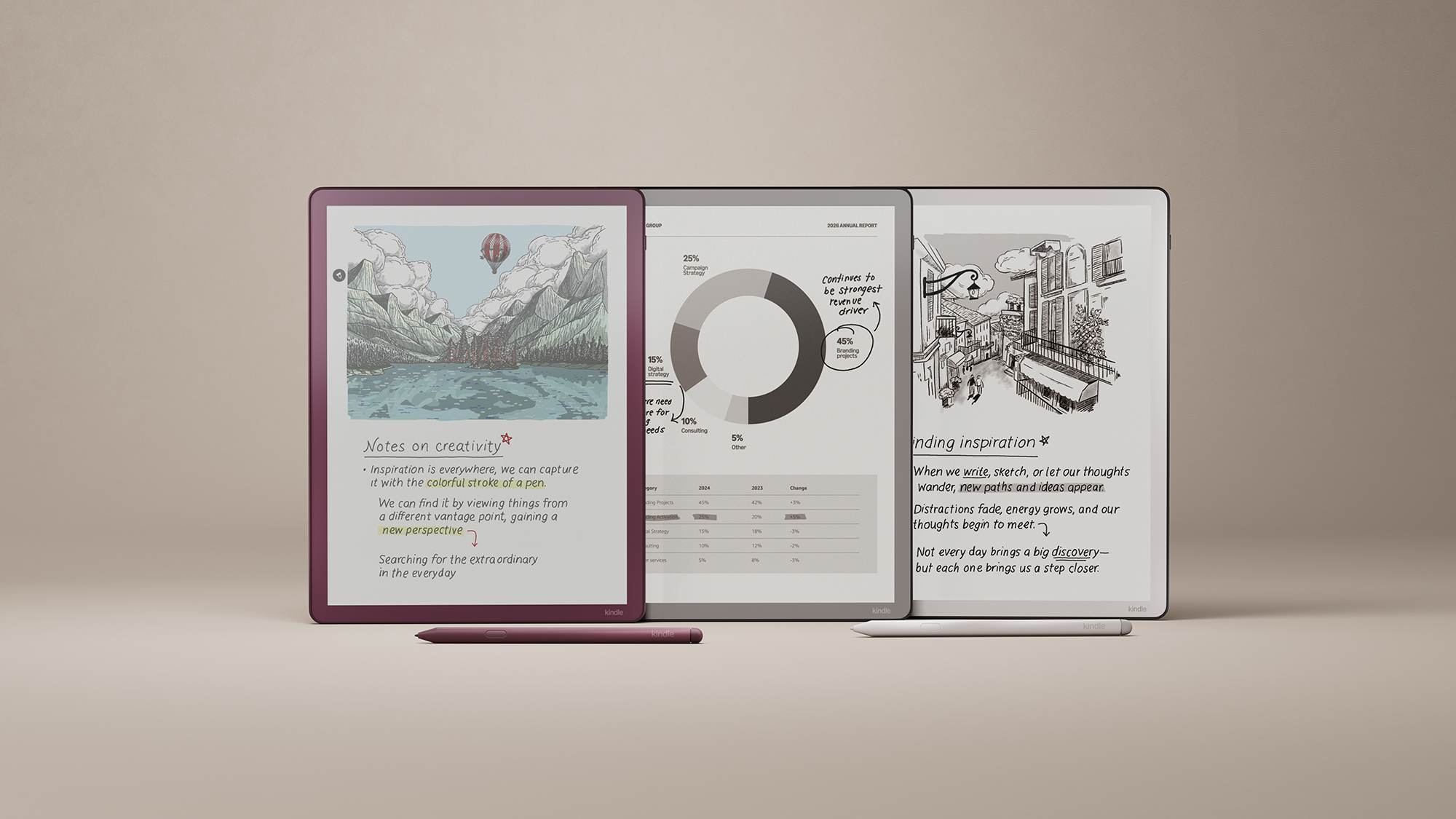If you want the closest thing to ‘paper’ for reading and writing, E-Ink tablets are the category to watch in 2025. The field now ranges from highly focused, distraction-free devices (reMarkable) to flexible Android-based E-Ink tablets (Onyx Boox) — and 2025 brought meaningful updates. That includes a new Kindle Scribe family.
Why this guide (and why E-Ink in 2025)
E-Ink tablets (sometimes called ‘digital paper’ or ‘e-paper tablets’) combine matt, paper-like displays with stylus input so you can read long-form content comfortably and take notes by hand. In 2025, the category expanded in two important directions:
- Premium, distraction-free note devices that focus on writing feel and minimal software friction (reMarkable lineage).
- Versatile Android E-Ink tablets that run apps, support more file types, and offer better hardware flexibility (Onyx Boox family).
Additionally, late-2025 saw major updates from Amazon (a refreshed Kindle Scribe line, now including a color Scribe for the first time) and increased interest in matte ‘paper-like’ LCD alternatives (e.g., TCL Nxtpaper) that compete for budget-minded readers.
At a glance — Quick comparison table
| Best for / Device | Screen | Stylus | OS / Apps | Battery | Typical price (USD) |
| Best all-round / Kindle Scribe (2025) | 11″ (grayscale + Colorsoft options) | Yes (improved pen) | Kindle OS (Amazon) | Multi-day to weeks (depends on color model) | $429–$699 (varies by model) |
| Best note-taking minimalist / reMarkable 2 | 10.3″ monochrome | Yes (Marker) | reMarkable OS | Up to ~2 weeks | ~$399 (base) |
| Best power user / Onyx Boox Note Air3 | 10.3″ (Carta / high refresh) | Yes; advanced | Android (third-party apps) | Good — single charge, varies with use | Mid–high range (varies) |
| Best budget / TCL Nxtpaper & matte LCDs | 8–11″ (matte LCD / Nxtpaper) | Some models support stylus | Android | Multi-day (but less than E-Ink) | ~$199 for some Nxtpaper tablets |
| Best full-featured large format / Onyx Boox Max / Lumi | 13.3″+ | Yes | Android | Good for documents | Premium, varies |
(Prices and availability can vary by region)
Top picks — short reviews & who each is for
1) Kindle Scribe (2025 lineup) — Best polished reading + note experience
Amazon refreshed the new Kindle Scribe line in late-2025 (new thinner/lighter hardware and a Colorsoft Scribe option that brings color writing/reading) along with improved software features such as Workspaces, better cloud integration and LLM-assisted search. If you live in the Amazon ecosystem, want great reading features plus handwriting, and value polished integration (Kindle store, notes-to-cloud), the Scribe family is now the most comprehensive mainstream offering.
Pros: Excellent reading experience, tight Kindle integration, new color option (for those who want it).
Cons: Amazon ecosystem can be limiting if you prefer open formats; color model is costlier.
2) reMarkable 2 — Best minimalist writing experience
reMarkable focuses on the tactile writing experience and a near-paper feel. The software emphasizes notes, sketching, and document markup with a clean, distraction-free UX. If your priority is handwriting, low friction, and a premium pen feel, reMarkable remains the benchmark.
Pros: Superb pen latency/feel, thin/light design, great for academics and writers.
Cons: Limited apps and ecosystem compared with Android-based E-Ink tablets.
3) Onyx Boox Note Air3 (and siblings) — Best for power users and app flexibility
Onyx Boox devices run Android and allow third-party apps (PDF tools, note apps, even limited web browsing). The Note Air3 blends solid E-Ink hardware with the flexibility of Android, making it ideal for users who need advanced document workflows. Reviews praise the performance and feature set, though the learning curve and software complexity can be higher.
Pros: Flexible, powerful, supports many formats and apps.
Cons: More complex UI; some readers report text rendering quirks versus pure e-reader displays.
4) TCL Nxtpaper / Matte LCD alternatives — Best budget-minded “paper feel” option
TCL’s Nxtpaper tablets and similar matte-LCD devices trade the long battery life of E-Ink for lower costs and full-color displays while offering a paper-like surface that reduces glare and blue light. These are great if you want a comfortable reading surface on a budget and occasional multimedia use. They’re not true E-Ink, but their price and color capability make them compelling alternatives.
Pros: Low price, color, runs full Android apps.
Cons: Battery life and eye comfort don’t match E-Ink; experience differs from true e-paper.
Buying guide — pick the right device for your use case
Screen size
- 7–8″ — Portable, great for one-hand reading.
- 10–11″ — The sweet spot for PDF reading and comfortable handwriting. Many e-paper note devices use ~10.3–11″.
- 13″+ — For designers, heavy PDF workflows and landscape reading.
Writing & stylus
- If handwriting quality is top priority, pen latency and the feel of the glass matter more than raw specs. reMarkable and many Boox devices invest heavily in pen tech.
Ecosystem & file compatibility
- Closed / Store-centric (Kindle): Great reading experience, easy purchase/management, limited native EPUB support without conversion.
- Open / Android (Boox): Supports many apps and file types — better for complex workflows.
Battery life
- True E-Ink devices can last days to weeks depending on brightness and use. Color or LCD devices generally require much more frequent charging.
Budget tiers
- Budget (~$150–$300): Nxtpaper/matte LCD tablets, older or smaller E-Ink models.
- Midrange (~$300–$500): Many Onyx Boox 10.3″ devices, reMarkable entry price points.
- Premium (~$500+): Larger E-Ink devices, color E-Ink models, or large-format Boox Max/Lumi devices.
Short buying recommendations (TL;DR)
- For most people who read & annotate: Kindle Scribe (2025) — best integrated reading + note experience, now with a color option for those who need it.
- For writers and note purists: reMarkable 2 — best paper-like pen experience.
- For power users who want apps: Onyx Boox Note Air3 (or other Boox models) — Android + E-Ink flexibility.
- For budget / color + reading: TCL Nxtpaper (and similar matte LCDs) — low cost and usable “paper” feel.
FAQs
Q — Are color E-Ink tablets worth it?
Color E-Ink is useful for magazines, comics, or textbooks where color matters. In 2025, color options (including Kindle’s Colorsoft variant) make the space more interesting, but color models are pricier and may trade off battery life or color fidelity compared with monochrome devices.
Q — Can I read PDFs well on E-Ink tablets?
Yes — larger E-Ink tablets (10.3″ and above) are especially good for PDFs. If you read a lot of PDFs, prioritize screen size, annotation tools, and good PDF software (Onyx Boox is strong here).
Q — Are E-Ink tablets better than iPads for reading?
For long reading sessions and eye comfort, yes — E-Ink wins. For multimedia, app variety, and color/refresh speed, an iPad is better. Choose the tool that matches the use case.
Closing — is an E-Ink tablet worth it in 2025?
If your main priorities are eye comfort for long reading sessions, paper-like handwriting, or focused note workflows, E-Ink tablets in 2025 are compelling, and the category has matured to offer options from distraction-free minimalists to full Android power users. Recent device refreshes (notably Amazon’s updated Scribe line) and improved alternatives (matte LCDs) mean there’s an option at nearly every price/performance point.


